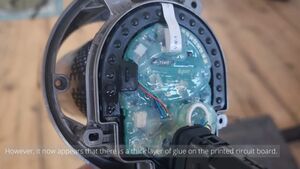Dyson: Difference between revisions
m Link wiki article Dyson ends relationship with 3rd party repair centers |
Added 4th example of incidents with v6 battery pack repairs |
||
| (11 intermediate revisions by 7 users not shown) | |||
| Line 1: | Line 1: | ||
{{StubNotice}} | {{StubNotice}} | ||
{{InfoboxCompany | {{InfoboxCompany | ||
| Name = Dyson | | Name = Dyson | ||
| Type = Private | |||
| Founded = 1991 | | Founded = 1991 | ||
| Industry = | | Industry = Household Appliances | ||
| Official Website = https:// | | Official Website = https://dyson.com/ | ||
| Logo = Dyson-Logo.webp | | Logo = Dyson-Logo.webp | ||
}} | }} | ||
[[File:Dyson-glued-button.jpg|thumb|Glued PCB, preventing | '''[[wikipedia:Dyson (company)|Dyson Limited]]''' is a manufacturer of home appliances (most notably vacuum cleaners), and has been involved in several incidents related to the aftermarket repair of its products, which are detailed below. | ||
== | |||
==Consumer impact summary== | |||
Dyson's policies have been troublesome for product longevity and repair. Dyson's battery design speeds up degradation, and adhesive on printed circuit boards makes easy repairs not possible, causing expensive replacements. Dyson also cut off third-party repair shops, restricting consumers and forcing them into manufacturer-recommended services. These policies add costs of ownership and shorten product lifespan, harming consumers.[[File:Dyson-glued-button.jpg|thumb|Glued PCB, preventing repair.<ref name=":0">https://www.youtube.com/watch?v=KF0nNOAFnRQ</ref>]] | |||
==Incidents<!-- Will split this into incidents and practices later on -->== | |||
===Battery lifespan reduction=== | |||
{{Main|Dyson intentionally reduces battery lifespan and makes them difficult to repair}} | |||
'''[[Dyson]]''' battery packs include a '''Battery Management System (BMS)''' equipped with a chip capable of balancing the individual cells. However, the manufacturer has chosen to omit a few inexpensive but essential resistors, preventing the balancing function from working as intended. As a result, the battery pack degrades much faster than it should. | |||
== References == | ===Circuit boards covered in glue=== | ||
{{Main|Dyson covers circuit board in glue which prevents repairs}} | |||
'''[[Dyson]]''' started applying a thick layer of glue to the circuit board, making it impossible to replace the power button when it breaks, and forcing customers to replace the entire housing. | |||
=== Deleting third-party repairs options === | |||
{{Main|Dyson ends relationship with third-party repair centers}} | |||
The company no longer allows repairs through third-party repair centers. Dyson described this decision as '<nowiki/>''difficult''<nowiki/>' but emphasized its commitment to ensuring that '''all services and repairs meet Dyson's high-quality standards for our owners''<nowiki/>'. | |||
=== Difficult to repair battery packs for Dyson V6 cordless vacuum === | |||
The Dyson V6 uses replacable battery packs that are available for purchase [https://www.dyson.com/support/journey/tools/967810-23 on their website]. The battery packs have plastic casing that is clipped shut in such a way that unclipping them requires damaging the casing. Additionally, the BMS used does not have a reset button. TronicsFix was unsuccessful in repairing the battery pack that was stuck sending the voltage without the button pressed down and he was forced to buy a replacement.[https://youtu.be/Wa1dsoZK4tk?t=1109] | |||
==References== | |||
<references /> | <references /> | ||
[[Category:Dyson]] | [[Category:Dyson]] | ||
Latest revision as of 11:40, 29 March 2025
❗Article Status Notice: This Article is a stub
This article is underdeveloped, and needs additional work to meet the wiki's Content Guidelines and be in line with our Mission Statement for comprehensive coverage of consumer protection issues. Issues may include:
- This article needs to be expanded to provide meaningful information
- This article requires additional verifiable evidence to demonstrate systemic impact
- More documentation is needed to establish how this reflects broader consumer protection concerns
- The connection between individual incidents and company-wide practices needs to be better established
- The article is simply too short, and lacks sufficient content
How You Can Help:
- Add documented examples with verifiable sources
- Provide evidence of similar incidents affecting other consumers
- Include relevant company policies or communications that demonstrate systemic practices
- Link to credible reporting that covers these issues
- Flesh out the article with relevant information
This notice will be removed once the article is sufficiently developed. Once you believe the article is ready to have its notice removed, visit the Discord (join here) and post to the #appeals channel, or mention its status on the article's talk page.
| Basic information | |
|---|---|
| Founded | 1991 |
| Type | Private |
| Industry | Household Appliances |
| Official website | https://dyson.com/ |
Dyson Limited is a manufacturer of home appliances (most notably vacuum cleaners), and has been involved in several incidents related to the aftermarket repair of its products, which are detailed below.
Consumer impact summary[edit | edit source]
Dyson's policies have been troublesome for product longevity and repair. Dyson's battery design speeds up degradation, and adhesive on printed circuit boards makes easy repairs not possible, causing expensive replacements. Dyson also cut off third-party repair shops, restricting consumers and forcing them into manufacturer-recommended services. These policies add costs of ownership and shorten product lifespan, harming consumers.

Incidents[edit | edit source]
Battery lifespan reduction[edit | edit source]
Dyson battery packs include a Battery Management System (BMS) equipped with a chip capable of balancing the individual cells. However, the manufacturer has chosen to omit a few inexpensive but essential resistors, preventing the balancing function from working as intended. As a result, the battery pack degrades much faster than it should.
Circuit boards covered in glue[edit | edit source]
Dyson started applying a thick layer of glue to the circuit board, making it impossible to replace the power button when it breaks, and forcing customers to replace the entire housing.
Deleting third-party repairs options[edit | edit source]
- Main article: Dyson ends relationship with third-party repair centers
The company no longer allows repairs through third-party repair centers. Dyson described this decision as 'difficult' but emphasized its commitment to ensuring that 'all services and repairs meet Dyson's high-quality standards for our owners'.
Difficult to repair battery packs for Dyson V6 cordless vacuum[edit | edit source]
The Dyson V6 uses replacable battery packs that are available for purchase on their website. The battery packs have plastic casing that is clipped shut in such a way that unclipping them requires damaging the casing. Additionally, the BMS used does not have a reset button. TronicsFix was unsuccessful in repairing the battery pack that was stuck sending the voltage without the button pressed down and he was forced to buy a replacement.[1]

